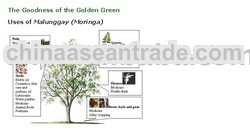MALUNGGAY(Moringa) leaves could practically wipe out malnutrition on our planet.
Experts agree that the long-term solution to malnutrition is the use of foods rich in the essential nutrients often lacking in people's diets. Modern scientific research is proving that MALUNGGAY(Moringa) leaves are one of the richest sources of such nutrients. Even small amounts of the leaves could protect thousands of people from suffering and death.
People in several countries have found that Moringa leaves are quite acceptableto taste, especially when added to common foods.
MALUNGGAY(Moringa) Leaves are full of essential disease-preventing nutrients:
Vitamin A, which acts as a shield against eye disease, skin disease, heartailments, diarrhea, and many other diseases.
Vitamin C, fighting a host of illnesses including colds and flu.
Calcium, which builds strong bones and teeth, and helps prevent osteoporosis.
Potassium, essential for the functioning of the brain and nerves.
Proteins, the basic building blocks of all our body cells.
Besides the leaves, the MALUNGGAY(Moringa) tree has many everyday uses. India'sayurvedic medicine uses every part of the MALUNGGAY(Moringa) tree and considers it one ofthe most valuable and useful plants.
The links on this page show some uses that we know about and also sometraditional medicinal uses that we would like to know more about.
Water Purification
Pods
Vegetable Oil
Uses in Traditional Medicine
More Uses
Uses in Traditional Medicine We have heard that:
The ayurvedic medicine of India has many uses for MALUNGGAY(Moringa) tree products, suchas a natural antibiotic, an aid in childbirth, for treating liver disorders,and many other uses.
Villagers in Omanuse Moringa oil to treat stomach disorders. They also use it in perfume andhair oil.
In Haiti,villagers boil Moringa flowers in water and drink the tea as a powerful coldremedy.
Dried Moringa leaves treat diarrhea in Malawi,Africa.
Moringa is a tropical tree with multiple uses and which is resistant todrought. Among the 13 species known, Moringa oleifera is particularly easy toreproduce and its growth is very fast. The numerous economic uses of Moringaoleifera together with its easy propagation have raised growing internationalinterest for this tree which originated from Indiaand which is found in most tropical countries (Africa, Asia and America).Moringa stenopetala and other species from Eastern Africa and Madagascar alsohave potential even though they have been less exploited so far.
Moringa seeds contain a cationic polyelectrolyte that has proved efficient inwater treatment, as a substitute to aluminium sulphate and other flocculent.There is a dual advantage to this property:
1) it can be used as a locally-produced substitute for imported flocculent,thus reducing expenditure of foreign currency reserves by third worldcountries;
2) Moringa flocculent, unlike aluminium sulphate, is completely biodegradable.This aspect may be particularly interesting to developed countries.
Several organisations have isolated the active polyelectrolyte to facilitateits use in water treatment plants as well as in algae farms and otherindustries using flocculation: wineries, paper manufactures, mines. Now that researchand application at the pilot scale have been achieved, production and use ofMoringa flocculent in real economic conditions is being developed.
Oil extracted from the seeds is an excellent edible vegetable oil and is alsouseful within the cosmetics industry. A dual usage of Moringa, as a source ofoil and flocculent, is possible, since the seed cake remaining after oilextraction retains the flocculating properties.
Moringa is also an important food source in many countries. In India, Moringapods are widely consumed and plantations exist to produce pods for export,fresh and tinned, to overseas consumers. In West Africa,Moringa oleifera leaves are commonly used to make sauces. Moringa stenopetalaleaves are the staple food of the Konso people in Ethiopia. Studies have shown theleaves to be an excellent source of vitamins, minerals and protein: perhapsmore than any other tropical vegetable. Many programs use Moringa leaves tofight against malnutrition and its associated diseases (blindness etc.).
Other potential applications of Moringa including use as livestock feed, plantgrowth hormone, green manure, medicines or for paper making are currently thesubject of various research efforts.
References:
Scientifically speaking, Moringa sounds like magic. It can rebuild weak bones,enrich anemic blood and enable a malnourished mother to nurse her starvingbaby. Ounce for ounce, it has the calcium of four glasses of milk, the VitaminC of seven oranges and the potassium of three bananas.
"Sounds like your Power Bar, you say? Well, consider this...Doctors use itto treat diabetes in West Africa and high blood pressure in India. -----Los Angeles Times-----
Moringa is a remarkable discovery which can make a tremendous difference inyour health and quality of life. Mounting scientific evidence shows what hasbeen known for thousands of years by people in the tropical parts of the world:Moringa is natures medicine cabinet.
It is best known as an excellent source of nutrition and a natural energybooster. Loaded with nutrients, vitamins and amino acids, it replenishes yourbody and provides what you need to get through a hectic weekday or activeweekend.
Yet this is not a sugar-based energy. Its not something which makes you hyperfor some period of intense activity then leaves you drained. In fact, Moringais also relaxingit helps to reduce blood pressure and assure a good nightssleep.
And Moringa is loaded with nutrients. Each ounce of Moringa contains seventimes the Vitamin C found in oranges, four times the Vitamin A of carrots,three times the iron of spinach, four times as much calcium as milk and threetimes the potassium of bananas.
Moringa has another, very personal, aspect to it also. I grow it at home and,living in Southern California, have planted itoutdoors as well. There is something special about being able to harvest thetender green leaves and put them directly into your salad. Or pick the greenpods , which are very much like large string beans, and eat them as part ofdinner a few minutes later Or take a handful of the fragrant flowers to make acup of aromatic, soothing tea. Moringa becomes a positive part of your lifewith very little effort.
<!--[if !supportLineBreakNewLine]-->
<!--[endif]-->
Similar products




